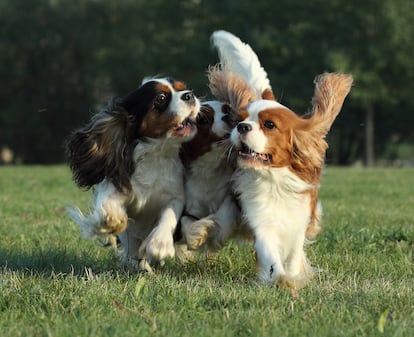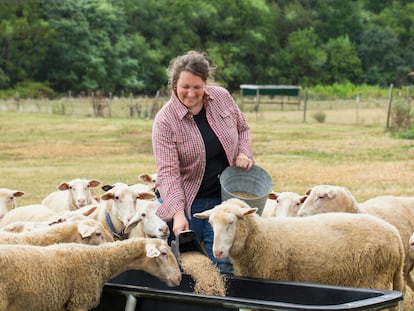What have we done to dogs? Selective breeding’s consequences on the health of social media-darling pets
The pursuit of aesthetic perfection causes pugs, bulldogs and dachshunds to suffer

TikTok is full of videos of “funny” snoring pugs. In recent decades, these dogs have become incredibly popular. But according to a study published in the journal Canine Medicine and Genetics these media-friendly animals have such severe breathing difficulties and health problems that they “can no longer be considered a typical dog from a health perspective.” Pugs, like other popular and viral breeds on social media, are the victims of selective breeding for aesthetic purposes.
“It greatly saddens us to see dogs struggling to breathe, walk, play and live normal, happy lives because they have been bred to look a certain way, whether for profit or to win a [dog] show,” the Royal Society for the Prevention of Cruelty to Animals says. According to the Federation of Veterinarians of Europe (FVE) and the European Federation of Companion Animal Veterinary Associations, selective breeding has increasingly focused on the appearance and popularity of certain breeds, with little regard for functionality, health or longevity.
Selective breeding aims to produce offspring with specific characteristics. “It has been done ever since we started interacting with dogs,” says Paula Pérez Fraga, a veterinarian with a master’s degree in companion animal behavioral medicine and a doctoral candidate in the Family Dog Project animal behavior group at the department of ethology at the University of Budapest.
About 15,000 years ago, selective breeding was done “for behavioral purposes.” Research published in the journal Science indicates that before the 19th century, dogs were selected primarily for functions such as hunting, guarding and herding. “Humans favored the reproduction of those individual animals that were more sociable and less fearful, so that the offspring were more docile and easier to handle,” says Fraga. Over time, dogs were selected “for certain vocalizations that could be advantageous to us—barking—or for their ability to communicate better with us at a distance.”
But in the 19th century, selective breeding began to emphasize morphology as well as temperament. Thus, “the concept of dogs as purely companion animals was born.” Since that time, breeders have prioritized the appearance that pet owners consider “aesthetically pleasing,” which has conditioned the dogs’ size and coat color or length. As Rowena Packer, a professor of companion animal welfare and behavioral sciences at the Royal Veterinary College in the United Kingdom, explains: “This has led to the proliferation of several hundred breeds of dogs internationally, with dogs being the most phenotypically diverse mammalian species on the planet.” Indeed, the Fédération Cynologique Internationale recognizes 356 breeds.
Selective breeding’s impact on dogs’ health
Selective breeding can be extremely useful to humans if done correctly, Packer says. It allows animals to perform specific tasks, like police dogs, herding dogs and service dogs that assist people with disabilities. The Royal Canine Society of Spain highlights another major advantage of selective breeding: it can reduce or eradicate inheritable diseases in certain breeds. “Such is the case with conditions such as hip dysplasia and progressive retinal atrophy, which are increasingly less prevalent thanks to responsible breeders’ use of scientific veterinary tools.”
However, in many other cases selective breeding has negatively impacted dogs’ health. For starters, Packer points out the problems related to “inbreeding.” She explains that “in an attempt to fix certain genetic traits in a population, breeders ‘lock down’ their breed’s gene pool so that outside genetics (genes from other breeds of dogs) can no longer enter,” she notes.
Within this restricted gene pool, some breeders select closely related individual animals for mating; for example, mothers reproduce with sons, fathers with daughters, brothers with sisters and grandparents with grandchildren. The expert emphasizes that “this further reduces genetic diversity and increases the likelihood of the offspring being affected by genetic health conditions such as deafness.”
There are many hereditary diseases that are more prevalent than normal in the specific dog breeds that garner millions of views on social media. Michael Aherne, a clinical assistant professor of cardiology at the University of Florida College of Veterinary Medicine, explains that such is the case with dilated cardiomyopathy in Doberman pinschers, degenerative mitral valve disease in Cavalier King Charles spaniels, arrhythmogenic right ventricular cardiomyopathy in Boxers, hip dysplasia in Labrador retrievers and subvalvular aortic stenosis in Golden retrievers. “The list of examples is virtually endless, and individuals in almost all breeds are at increased risk for one disease or another,” he points out.

The price of ‘pretty’ dogs
In addition to the problems associated with inbreeding, there are other issues that stem from the selection of traits that are aesthetically pleasing to humans but detrimental to dogs. Packer explains that this often starts with naturally occurring genetic mutations, such as brachycephaly—characterized by an abnormally flattened face—and chondrodystrophy, abnormally shortened legs.
Because many humans find these features attractive, “instead of avoiding these mutations, [people] have proliferated and often exaggerated them into some of the extreme forms we see today.” While brachycephaly usually affects popular flat-faced breeds such as pugs and bulldogs, chondrodystrophy occurs in long-backed, short-legged breeds such as dachshunds, also known as sausage dogs.
In brachycephalic dogs, selective breeding for aesthetic purposes has resulted in shorter skulls compared to other breeds, Aherne explains. He adds that the soft tissues of the nose and throat have not been reduced in size to adapt to the smaller skull, which can cause “major problems by obstructing their upper airways.”
In addition to the fact that these dogs may have difficulty breathing, they sometimes experience eye problems as a result of their bulging eyeballs; dental disease, because their mouths lack room for their teeth; and problems giving birth naturally (because of their large heads and small hips, puppies can become trapped in the birth canal).
Chondrodystrophy frequently affects dachshunds. Packer says that this condition causes about a quarter of these dogs to have a slipped disc in their backs, “resulting in extreme pain, weakness and often paralysis. Often these disorders require surgery to reduce suffering, which can cost many thousands of euros but still does not guarantee that the dogs will have a good quality of life,” she says.
The onset of many diseases can be significantly influenced by other factors, such as diet, environment and exercise. “If you know that your dog has or might be predisposed to a certain disease, there are some measures you can take to prevent a serious manifestation of the disease,” says Aherne, who advises routine veterinary visits.
All these problems have led some countries to prohibit the selective breeding of certain dogs. For instance, the Netherlands has banned ownership of some brachycephalic dogs, and Norway has banned owning Cavalier King Charles spaniels. In Spain, article 27 of the animal welfare law forbids “performing genetic selection activities or practices that lead to serious problems or alterations in the animal’s health.”
So, is it recommended that people avoid getting a dog that is the product of selective breeding for aesthetic purposes? “Speaking strictly from an animal health perspective, yes, it is advisable to avoid getting selectively bred dogs, as most purebred pets are at risk of suffering from various hereditary diseases, and dogs that are not purebred are going to have a reduced risk,” Aherne points out. However, practically speaking, he believes that selective breeding for aesthetic purposes is unlikely to disappear any time soon. In addition to the fact that many breeders make a living from it, “many dog lovers have their favorite breeds and want them to continue.”
When aesthetics endanger cats
Some cats have also fallen victim to selective breeding for aesthetic purposes. According to some studies, people have sought to preserve "apparently desirable traits" in cats, like dogs, since the 19th century, especially those features associated with coat color and length, body size and shape, and eye color and shape.
Some popular breeds with flat faces, such as Persian and British Shorthair cats, have an increased risk of experiencing difficulty breathing. A study published in Scientific Reports indicates that Persian cats and others with short muzzles may also suffer from dental problems, such as malocclusion, which occurs when teeth do not align properly and can cause pain and difficulty eating. Eye conditions are also common in Persians, due to their large eye sockets.
In addition, research published in Frontiers in Veterinary Science indicates that the selective breeding of cats may have affected their ability to communicate effectively through facial expressions. "Our preference that they have features that we find cute or similar to expressions we recognize in humans (such as sweetness, vulnerability, or the appearance of moodiness) may have unintentionally altered their ability to express themselves and communicate clearly," says Lauren Finka, a specialist in feline behavior and welfare and one of the authors of the study.
Sign up for our weekly newsletter to get more English-language news coverage from EL PAÍS USA Edition
Tu suscripción se está usando en otro dispositivo
¿Quieres añadir otro usuario a tu suscripción?
Si continúas leyendo en este dispositivo, no se podrá leer en el otro.
FlechaTu suscripción se está usando en otro dispositivo y solo puedes acceder a EL PAÍS desde un dispositivo a la vez.
Si quieres compartir tu cuenta, cambia tu suscripción a la modalidad Premium, así podrás añadir otro usuario. Cada uno accederá con su propia cuenta de email, lo que os permitirá personalizar vuestra experiencia en EL PAÍS.
¿Tienes una suscripción de empresa? Accede aquí para contratar más cuentas.
En el caso de no saber quién está usando tu cuenta, te recomendamos cambiar tu contraseña aquí.
Si decides continuar compartiendo tu cuenta, este mensaje se mostrará en tu dispositivo y en el de la otra persona que está usando tu cuenta de forma indefinida, afectando a tu experiencia de lectura. Puedes consultar aquí los términos y condiciones de la suscripción digital.
More information
Últimas noticias
Most viewed
- Oona Chaplin: ‘I told James Cameron that I was living in a treehouse and starting a permaculture project with a friend’
- Reinhard Genzel, Nobel laureate in physics: ‘One-minute videos will never give you the truth’
- Sinaloa Cartel war is taking its toll on Los Chapitos
- Why the price of coffee has skyrocketed: from Brazilian plantations to specialty coffee houses
- Silver prices are going crazy: This is what’s fueling the rally











































